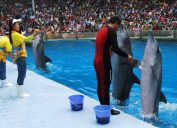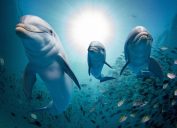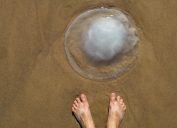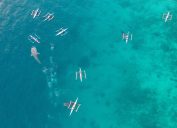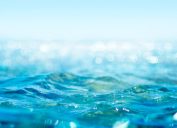20 Facts About Dolphins That Will Make You Love Them Even More
There's more behind these friendly faces.

Everyone loves dolphins. They're finned, they're fun, and they're particularly friendly to humans. Sure, you know dolphins are enchanting, but these sea creatures are a whole lot more than meets the bottlenose. From listening with their mouths to remembering names for decades, these 20 jaw-dropping facts prove dolphins are the coolest creatures in the ocean—and maybe even on the entire planet!
1
A dolphin's skin regenerates every two hours.
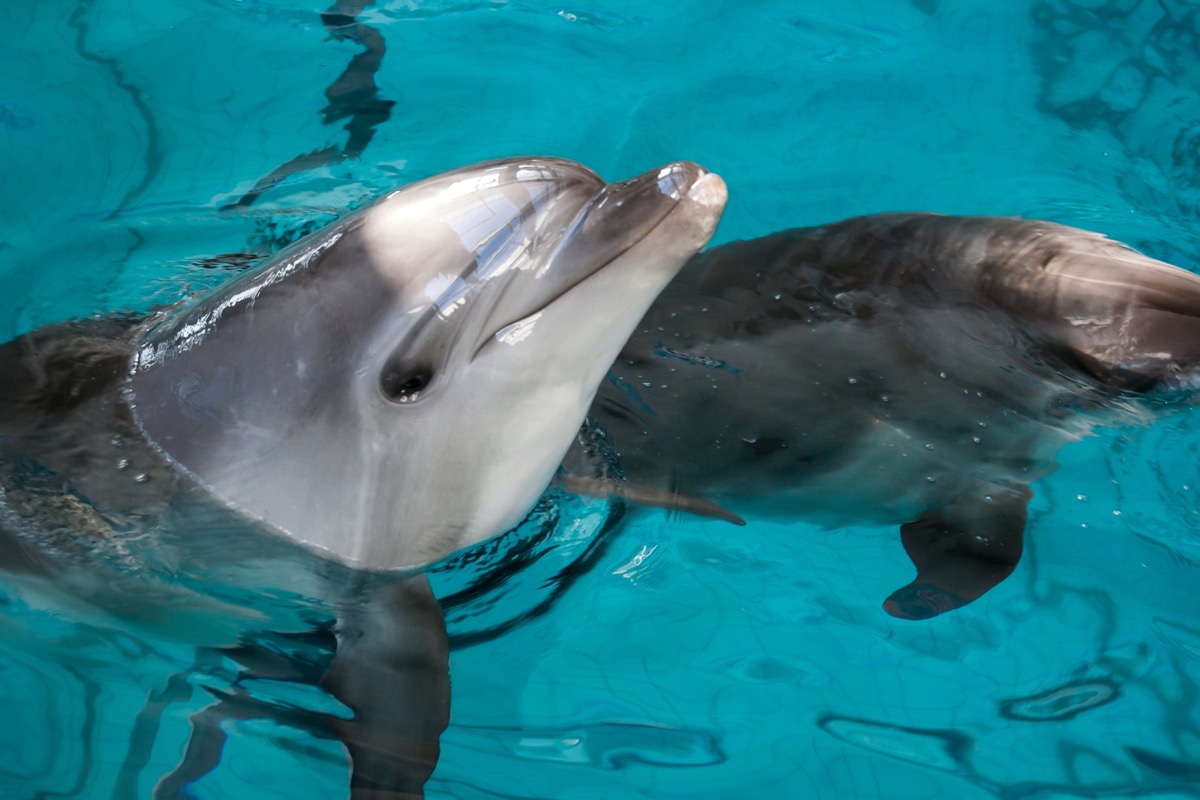
The dolphin's skin, which is smooth and rubbery, plays an important part in their movement under water. In order to swim as efficiently as possible, a bottlenose dolphin's skin flakes and peels to have new skin cells replace old cells almost every two hours—which is nine times faster than humans. This helps ensure a smooth body surface to increase the ease of their swimming under the sea.
2
They can actually speak to one another.
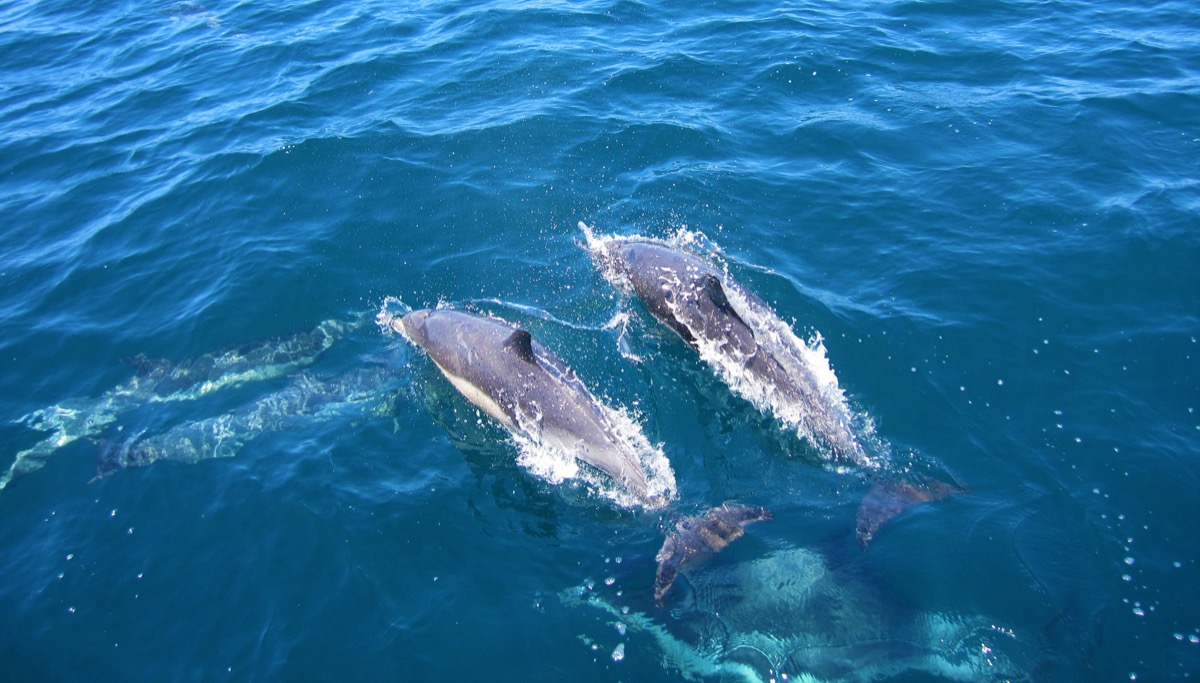
Scientists have found that dolphins have a "highly developed spoken language" much like that of humans, making a combination of pulses, clicks, and whistles that allow them to communicate. One 2016 study, published in Physics and Mathematics, describes how the language "exhibits all the design features present in the human spoken language, [which] indicates a high level of intelligence and consciousness in dolphins… [T]heir language can be ostensibly considered a highly developed spoken language."
3
Dolphins have the longest memories of any animal.

Forget elephants—dolphins are the animals with the longest-lasting memories. Research published in the Proceedings of the Royal Society B in 2013 proved that bottlenose dolphins can remember the whistles of other dolphins that they lived with for two decades, even when they were separated from one another. While elephants and chimpanzees have both been found to have impressive recall, neither comes close to a 20-year period of memory.
4
Dolphins recognize themselves in mirrors.

Usually, when an animal looks into the mirror they either ignore what they see, or think the reflection is another animal and act aggressively. Not so with dolphins—who can recognize that it is not another animal looking at them, but rather their own reflection. For a definitive 2001 study at the New York Aquarium, researchers installed mirrors in the tank of a pair of bottlenose dolphins, marking each dolphin with temporary ink—which the dolphin then stared at in the mirror. "Our findings show that self-recognition may be based on a different neurological substrate in dolphins," the researchers concluded.
5
Dolphins listen with their jawbones.

Scientists believe that sound is carried from the water to the dolphins' inner ear by way of its lower jawbone. The jaw is hollow (unlike land-dwelling mammals) and contains a fatty substance that connects up to the ear. When a dolphin's lower jaw is covered, it has trouble distinguishing sounds, while covering its ears has no impact on its ability to hear.
6
Dolphins are conscious breathers.

Humans are unconscious breathers. We breathe in and out without realizing it, whether we're asleep or awake or just totally unaware. Dolphins, however, have to make an active decision about each and every breath. As Bruce Hecker, director of husbandry at the South Carolina Aquarium, told Scientific American, a dolphin must be fully aware that their blowhole is at the surface, and then deliberately make the choice to inhale.
7
And they can inhale eight gallons of air in a single second.

A study published in the Journal of Experimental Biology in 2015 analyzed the breathing patterns of dolphins. The researchers found that they could inhale eight gallons of air in a second and exhale 34 gallons per second—three times faster than humans, allowing them to replace as much as 95 percent of the air in their lungs in a single breath.
8
Dolphins' eyes move independently.

While humans' eyes move in the same direction, coordinating with each other, dolphins have much more leeway—with each eye located laterally on the sides of their heads and operating independently from one another. This means that they can get a far more expansive view of what's happening around and even behind them as they swim through predator-filled water. But that's not all…
9
They literally sleep with one eye open.

According to the Whale and Dolphin Conservation, dolphins only rest half of their brain at any given time. For one period of sleep, they'll rest their left brain; then, they'll do the same with their right brain.
That means that part of their brain can still open the blowhole while it's above the water to take in air while the other part of the brain is sleeping. You can actually tell which part of a dolphin's brain is currently active since their opposite eye remains open, allowing it to swim straight and watch for predators.
10
And they live on power naps.
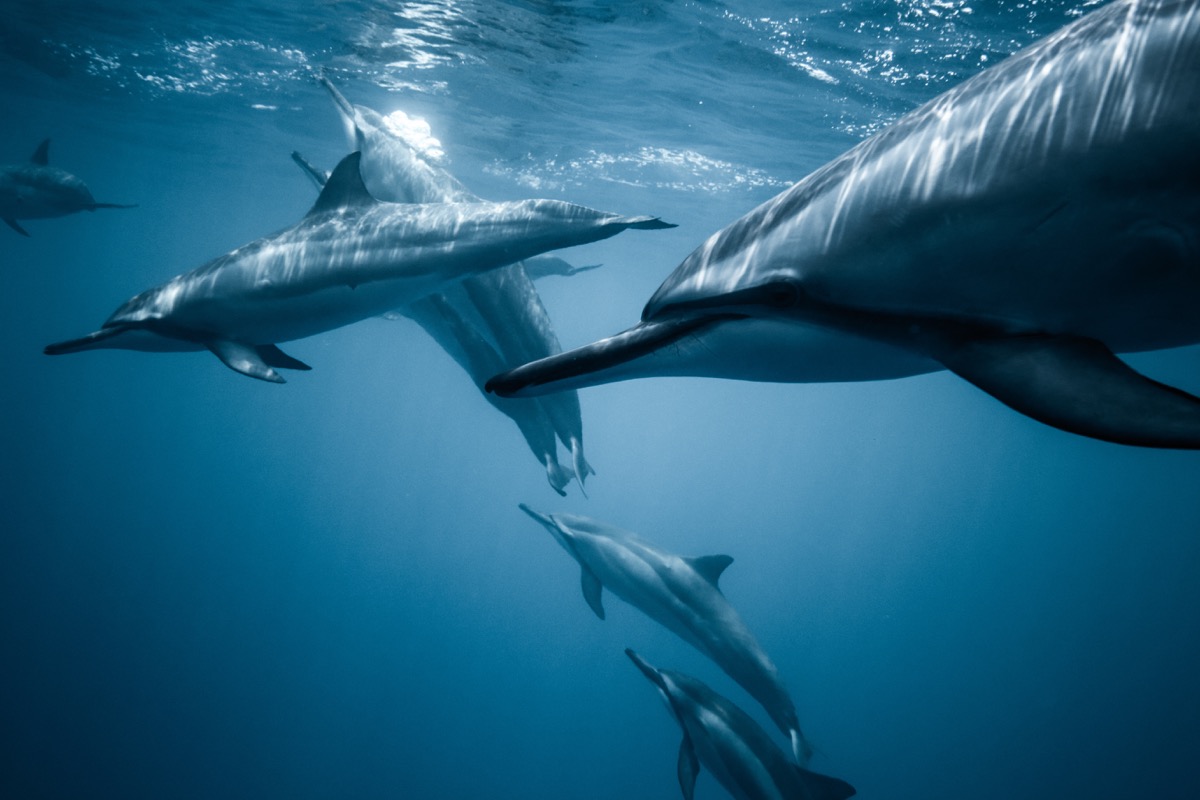
Dolphins can't just conk out for the night and get a solid eight hours of peaceful sleep like we humans do—they'd drown if they tried it. (See: that whole active breathing thing.) Instead, the Dolphin Research Center in Florida told Mental Floss they take power naps of 15 to 20 minutes throughout the day, allowing them to get rest without risking being under water for too long.
11
Some can jump as high as 15 feet!
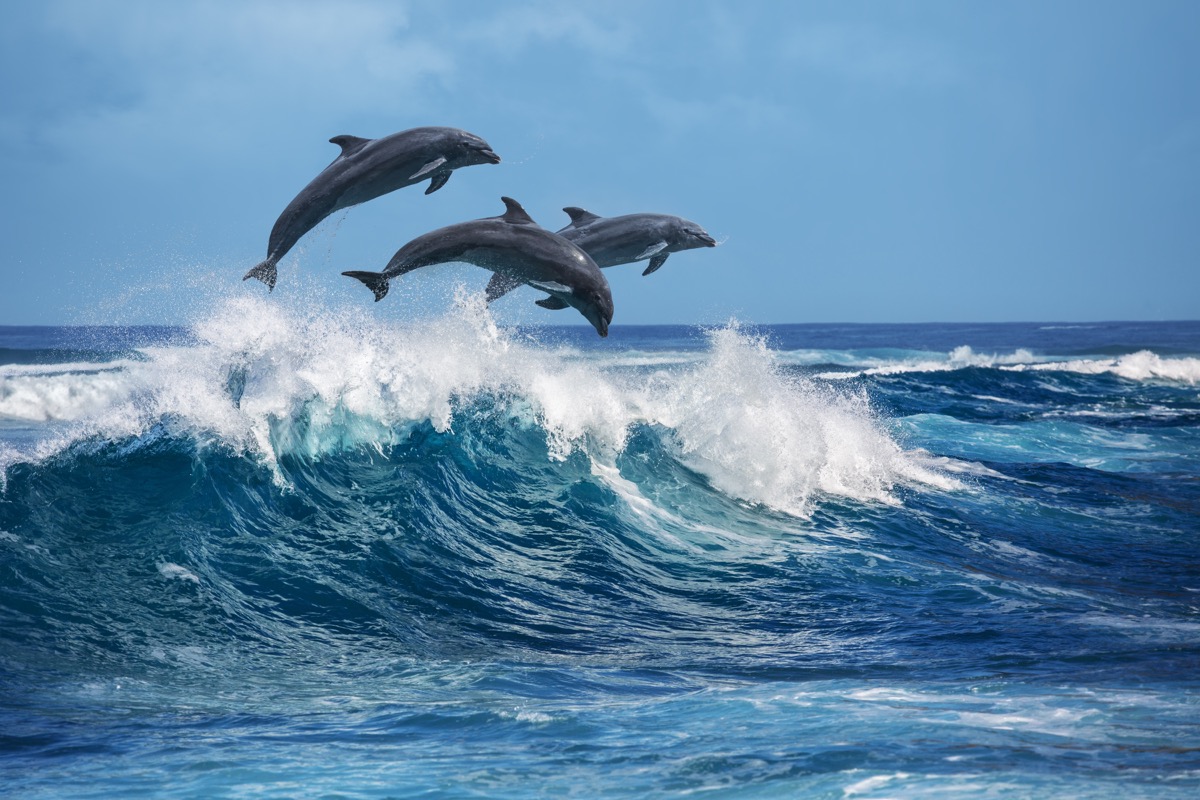
Dolphins can get some serious air. Researchers at the Wild Dolphin Foundation, for example, have reported seeing dolphins jump in the wild as high as 15 feet—with the spinner, spotted, and Commerson's dolphins tending to be the highest jumpers. The reason for this behavior? It requires less energy to jump than swim, since the air is less dense than the water.
12
The ancient Greeks called dolphins "sacred fish."

The ancient Greeks were big fans of dolphins, calling them "hieros ichthys," which translates to "sacred fish." The animals played a role in some Greek myths (usually portrayed as benevolent creatures assisting the characters). They were believed to be especially friendly to mankind, and killing a dolphin was considered sacrilegious.
13
And many philosophers incorporated dolphins in their writings.
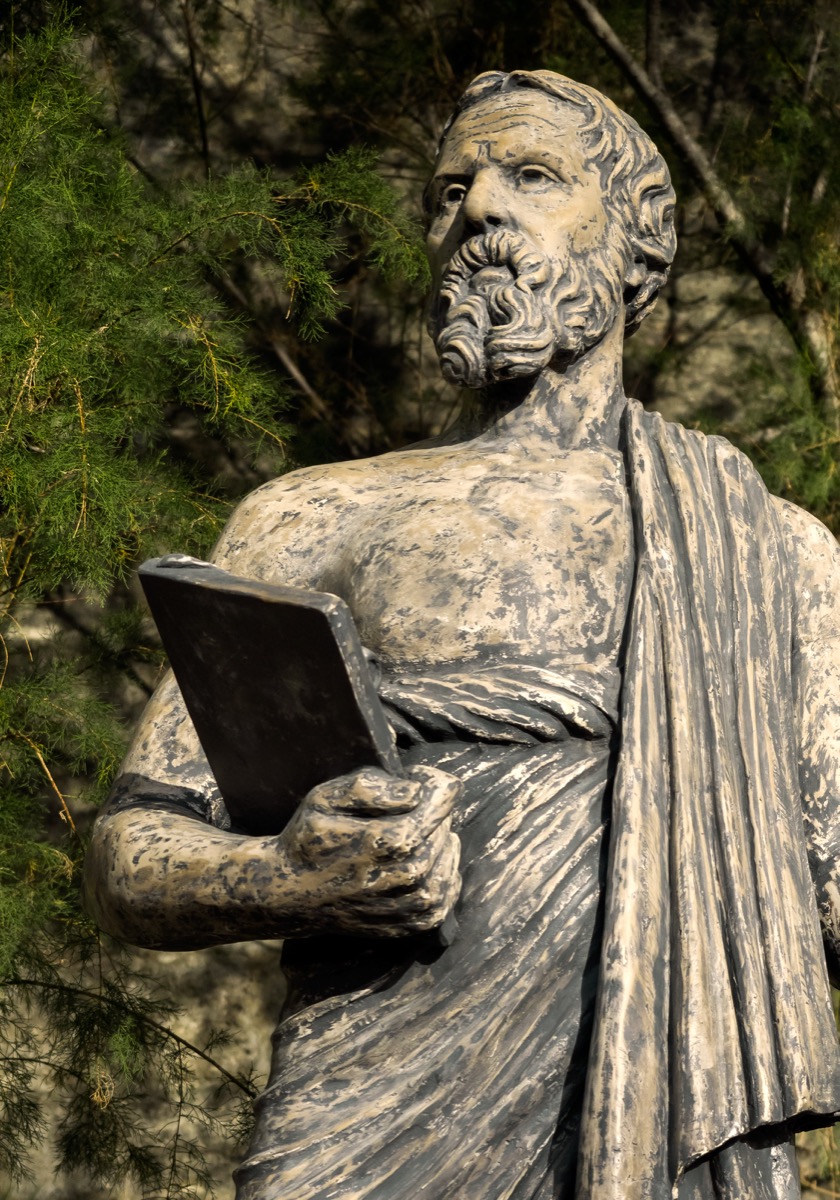
Ancient thinkers such as Pliny, Herodotus, Aelian, and Aristotle commented on the moral nature of dolphins and their human-like traits. For example, Pliny told the story of a boy who, swimming across a lake, encountered a dolphin that took him on his back and "carried the poor frightened fellow out into the deepest part; when immediately he turns back again to the shore, and lands him among his companions." And Aristotle reflected on, "The voice of the dolphin in air is like that of the human in that they can pronounce vowels and combinations of vowels."
14
They live in rivers, too.

We usually think of dolphins as being dwellers of the salty ocean, but there are seven species of dolphin that prefer the fresh water of the river—including the Amazon river dolphin, the South American tucuxi, and the Irrawaddy dolphin (which can live in both salt and fresh water). Sadly, a number of these species are listed as endangered or vulnerable, such as the Ganges river dolphin, of which there are fewer than 2,000 left.
15
Baby dolphins are born tail first.

To prevent drowning, a baby dolphin is born with its tail first, and the mother swiftly breaks the umbilical cord by swimming away fast before doing a U-turn and rapidly escorting her newborn to the surface so it can take a breath. In other words, the new mom does not get a lot of time to rest after giving birth. (Incidentally, when a baby dolphin nurses, it has to hold its breath.)
16
Dolphins are extremely maternal.
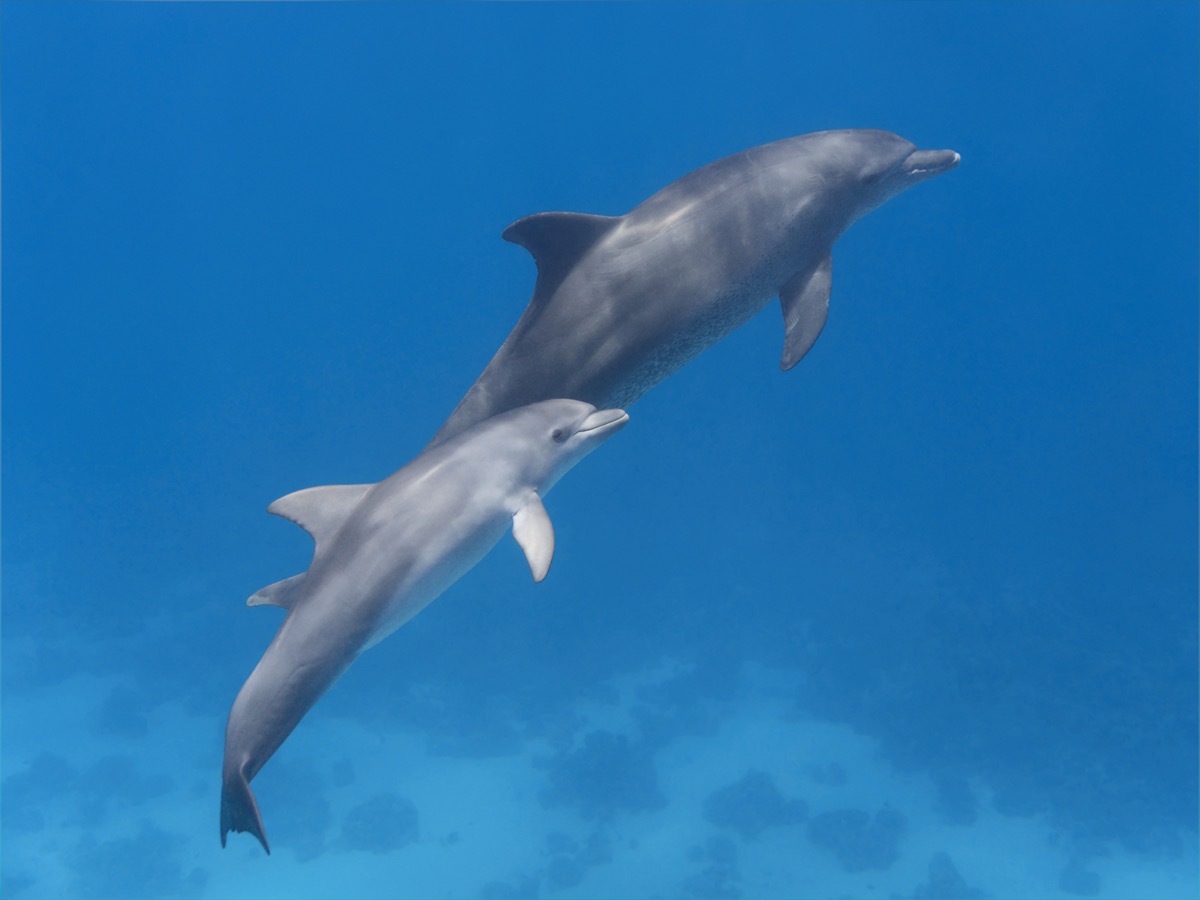
Some animals get a bad rap for pushing their young out into the wild as soon as they're born—but not dolphins. According to Shimi Kang, MD, author of The Dolphin Way: A Parent's Guide to Raising Healthy, Happy, and Motivated Kids—Without Turning into a Tiger, we could actually learn something from the parenting skills of these sea creatures!
As King wrote for HuffPost, these creatures have both "a balanced authoritative parent-child relationship and a balanced lifestyle, including what many of today's kids are missing—play and exploration, a sense of community and contribution, and the basics of regular sleep, exercise, and rest."
17
They love to play-fight.
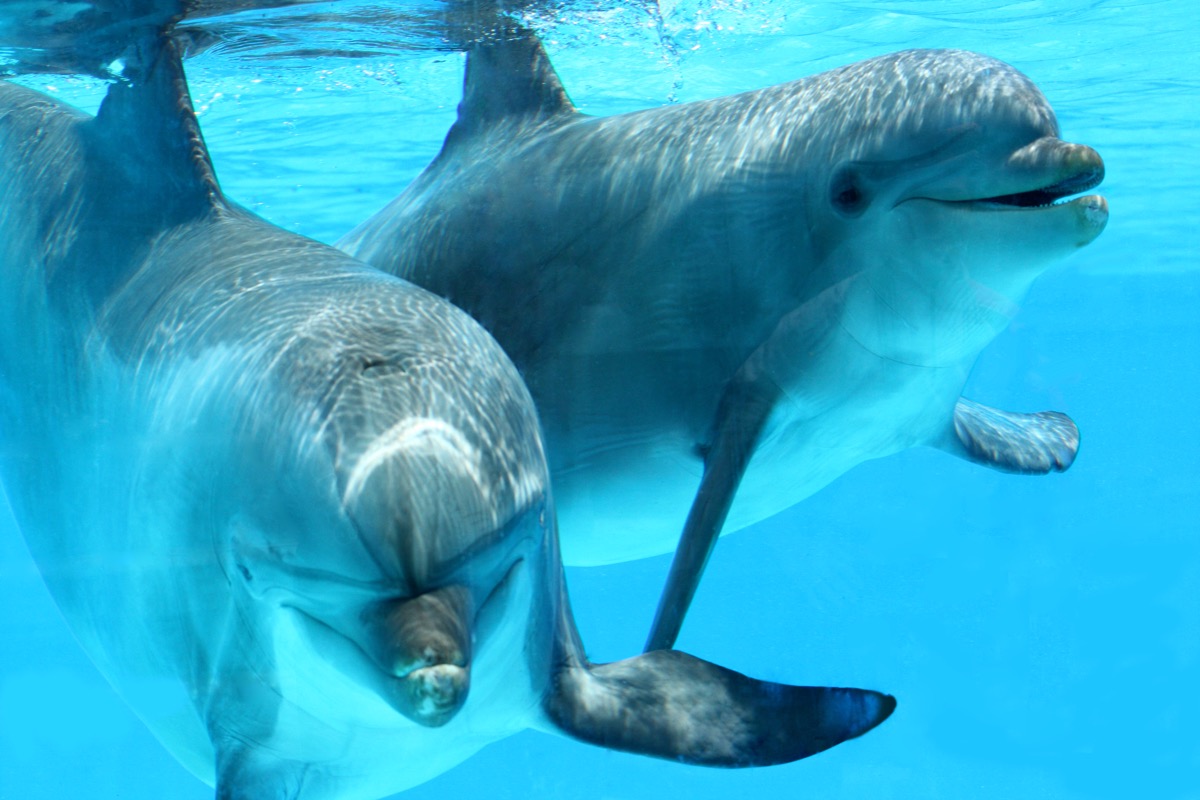
Dolphins are friendly creatures, no doubt. But just like humans, they love to goof off with their friends. In 2014, researchers from the University of South Mississippi observed dolphins play-fighting as if they were children. And, according to their findings, this type of play actually helps dolphin calves practice and perfect their locomotor and social skills.
18
Dolphins enjoy intimacy.
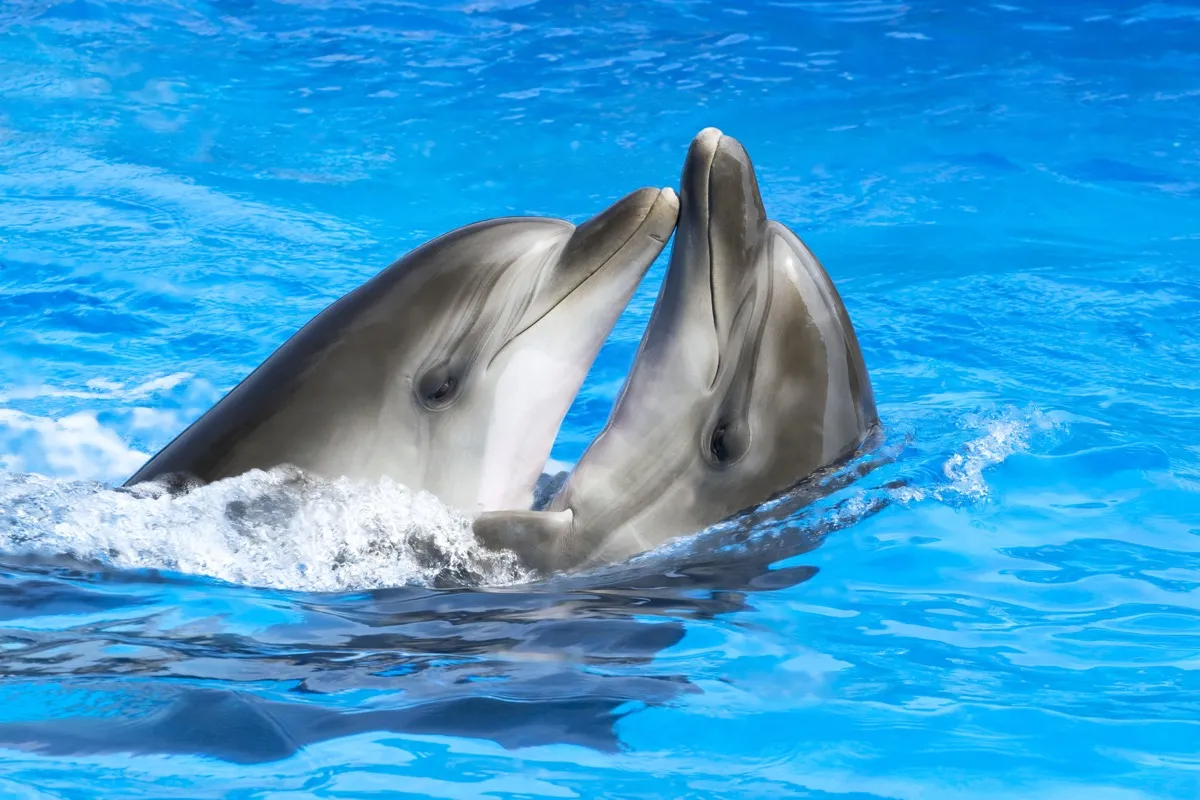
One of the few animals besides humans to enjoy intercourse are dolphins, Dara Orbach, a marine mammologist at Dalhousie University in Halifax, Canada, told Science. They have been known to practice foreplay and numerous positions when copulating.
19
And they can live as long as humans.

Fun fact: The orca whale is a species of dolphin, not a whale. Even more fun fact: While the average orca lives to about 50, it's not uncommon for them to get to 70 or 80 years old. The funnest fact? An orca named Granny lived until she was 105 years old!
20
Every year, dolphin teeth grow a new layer.

Speaking of dolphin ages… these creatures grow a new layer of teeth every year, creating rings that tell you how old each dolphin is (not unlike a tree). And for more incredible facts about life under the sea, check out 33 Mind-Blowing Facts About the Earth's Oceans.
To discover more amazing secrets about living your best life, click here to follow us on Instagram!

